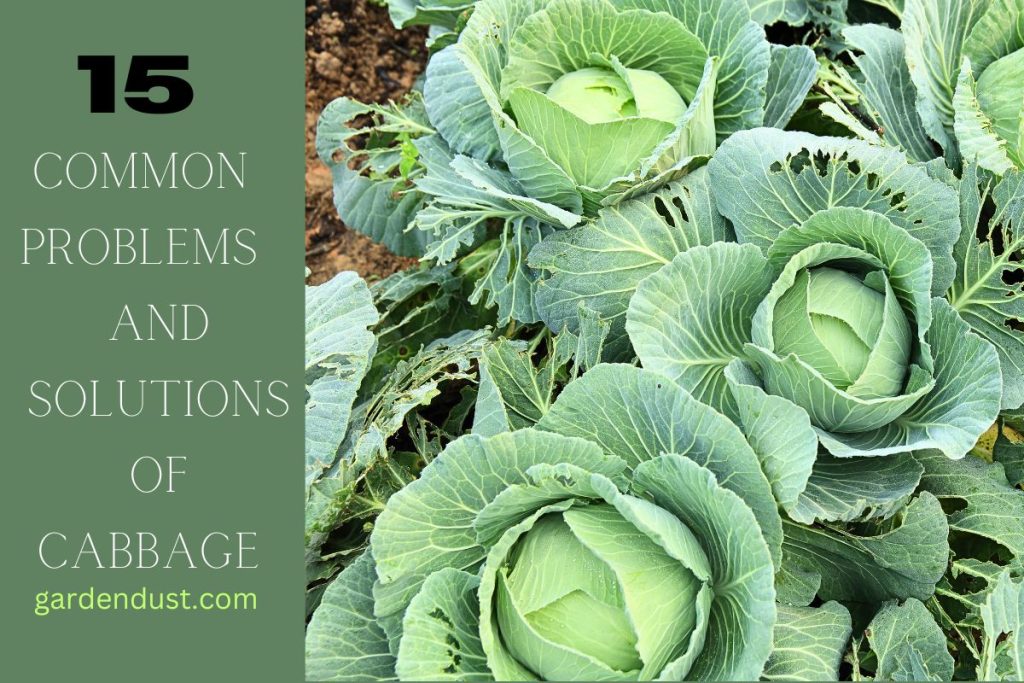Cabbage is a popular and nutritious vegetable that finds its way into gardens all around the world. However, like any other plant, cabbage plants can face a range of problems that hinder their growth and overall health. Understanding these common issues and learning how to address them can help gardeners maintain thriving cabbage crops. In this article, we’ll delve into 15 of the most common problems that garden cabbage plants encounter and provide detailed solutions for each.
1-Pest Infestations:
Cabbage plants are susceptible to various pests such as cabbage worms, aphids, and cabbage loopers. These insects can chew through leaves, causing significant damage to the plant.
How to Solve Them?
Introduce natural predators like ladybugs, use neem oil spray, or set up physical barriers like floating row covers to prevent pests from reaching the plants.
2-Diseases:
Cabbage plants can suffer from diseases like clubroot, black rot, and downy mildew. These diseases often result in stunted growth, yellowing leaves, and even death.
READ ALSO:-6 Natural Ways To Get Rid Of Mealybugs
How to Solve Them?
Rotate crops to prevent disease buildup, practice good sanitation, and use disease-resistant cabbage varieties. Applying fungicides as a preventive measure can also be effective.
3-Poor Soil Conditions:
Inadequate soil quality, pH imbalance, or nutrient deficiencies can lead to poor cabbage growth and development.
How to Solve Them?
Test soil for pH and nutrient levels before planting. Amend the soil with compost and organic matter to improve drainage and fertility.
4-Inconsistent Watering:
Uneven watering can lead to cracked heads, split leaves, and stressed plants.
How to Solve Them?
Maintain consistent watering, providing about 1-1.5 inches of water per week. Use mulch to retain moisture and prevent evaporation.
5-Overhead Watering:
Wetting the cabbage leaves excessively can encourage fungal diseases and rot.
How to Solve Them?
Water at the base of the plants to avoid wetting the leaves. Drip irrigation or soaker hoses are ideal for this purpose.
6-Weed Competition:
Weeds compete with cabbage plants for nutrients, water, and sunlight.
How to Solve Them?
Regularly weed the cabbage bed to reduce competition. Mulching can also help prevent weed growth.
7-Temperature Extremes:
Cabbage plants are sensitive to temperature fluctuations, especially extreme heat or sudden cold snaps.
How to Solve Them?
Choose appropriate cabbage varieties for your climate. Provide shade during hot spells and use frost protection during cold snaps.
8-Inadequate Spacing:
Planting cabbage too closely can lead to overcrowding, poor air circulation, and increased susceptibility to diseases.
How to Solve Them?
Follow spacing recommendations on seed packets or plant labels to ensure proper air circulation and healthy growth.
9-Nutrient Deficiencies:
Insufficient nutrients, particularly nitrogen, can lead to pale or yellowing leaves and reduced cabbage growth.
How to Solve Them?
Fertilize cabbage plants with a balanced fertilizer and monitor nutrient levels throughout the growing season.
10-Uncontrolled Cabbage Growth:
If cabbage plants grow too quickly due to excessive nitrogen or other factors, they may split or crack.
How to Solve Them?
Avoid over-fertilization and maintain consistent watering to prevent rapid growth.
11-Sunburn:
Intense sunlight can lead to sunburn on cabbage leaves, causing brown patches and reduced growth.
How to Solve Them?
Provide shade during the hottest parts of the day using row covers or shade cloth.
12-Root Damage:
Rough handling during transplanting or cultivation can damage cabbage roots and stunt growth.
How to Solve Them?
Handle plants gently during transplanting and avoid disturbing the root zone during cultivation.
13-Improper pH:
Cabbage prefers slightly acidic soil. Incorrect pH levels can lead to nutrient uptake issues.
How to Solve Them?
Test and adjust soil pH to around 6.5 using lime or sulfur as needed.
14-Late Planting:
Planting cabbage too late in the season can lead to smaller heads and increased susceptibility to pests and diseases.
How to Solve Them?
Follow recommended planting dates for your region to ensure optimal growth.
15-Lack of Crop Rotation:
Planting cabbage in the same spot year after year can lead to soil-borne diseases and reduced yields.
How to Solve Them?
Practice crop rotation, avoiding planting cabbage in the same area more than once every three years.
Final Thoughts
Successful cabbage cultivation requires vigilance, knowledge, and the ability to address potential problems promptly. By identifying and understanding these 15 common issues that affect garden cabbage plants, you can take proactive measures to prevent them and ensure the health and productivity of your cabbage crops. Remember that each problem may have unique solutions, so it’s essential to tailor your approach based on the specific challenges your cabbage plants are facing. Happy Gardening…







